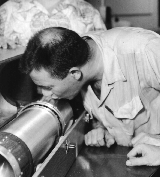|
[an error occurred while processing this directive]
#9H. Trapped Radiation -- History
|
(Files in red–history) |
Stoermer's CalculationsAn isolated magnetic pole is a mathematical abstraction and has not been observed (though a few people keep trying). Later Birkeland built bigger vacuum chambers and replaced the magnet with a magnetized sphere or "terrella" representing the Earth, noting that the electrons were channeled towards both its poles. A more practical problem, therefore, was particle motion near a compact bar magnet or "dipole", which better modeled the field of the Earth or of his terrella. Birkeland therefore suggested that problem to a friend, the mathematician Carl Stoermer, who devoted to it an appreciable part of his career. Stoemer never found a full solution, a formula which would predict the particle's motion to all time, like the formula for the motion of a single planet around an isolated sun. In fact, none exists in conventional mathematical terms, because the motion is inherently intricate (in today's terms, a "chaotic motion," an area pioneered by Poincaré). But he did show that large families of orbits would remain trapped forever.The orbits Stoermer was most concerned with belonged to particles with rather high energies. In general they did not resemble tidy spirals, because they covered large sections of the magnetic field, and in the course of each excursion around the field, the intensity and direction of the magnetic field did not stay the same but varied appreciably. Later, when cosmic rays were discovered, it turned out that Stoermer's theory applied quite well to their motion: but it did not solve the mystery of the polar aurora, as Stoermer had hoped.
|
|
Scientists in those days also wondered whether trapped particles were the cause of the mysterious "ring current" responsible for magnetic storms, but it was hard to imagine a process which created enough ions or electrons of cosmic ray energies to sustain them. Only in 1957 did S. Fred Singer (U. of Maryland) propose that the ring current may be carried by particles of much lower energies, injected somehow into trapped orbits during magnetic storms. In the following year the radiation belt was discovered--existing all the time, not just during storms--and gradually the details fell into place. Meanwhile in the 1950s efforts began to confine plasma in laboratory magnetic fields for producing controlled nuclear fusion, and in the process the theory of trapped particles was greatly developed and expanded.
As a grand experiment he proposed in October 1957 to the US Air Force to launch rockets with small atomic bombs, and detonate them in space. Atomic bombs produce large numbers of energetic electrons, and Christofilos hoped that such electrons would become trapped in the magnetic field as an artificial radiation belt. That project, conducted in secrecy and code-named Argus, received a great boost when Van Allen's Explorers 1 and 3 discovered the natural radiation belt, and it was carried out above the Southern Atlantic in August and September 1958. Three bombs were exploded outside the atmosphere, above a deserted stretch of ocean, and the public only learned about it the following year, when many related scientific studies were published.
|
|
The bombs indeed produced many high-energy electrons. Some of these were guided upwards along magnetic field lines, followed those lines across the equator and came down again near the Azores islands, where a remarkable artificial aurora was seen, in a region where no auroras had ever been observed before. Other electrons mirrored above the atmosphere and stayed trapped, creating artificial radiation belts which gradually decayed in the matter of weeks. The new belts were studied by the satellite Explorer 4, built for this purpose by Van Allen's group at the University of Iowa.
Further Reading:
|
Next Stop: #10. Motion of Trapped Radiation
- Back to the Index Page
Timeline Expanded timeline Glossary
Author and Curator: Dr. David P. Stern
Mail to Dr.Stern: education("at" symbol)phy6.org
Co-author: Dr. Mauricio Peredo
Spanish translation by J. Méndez
Re-formatted 3-11-2006

